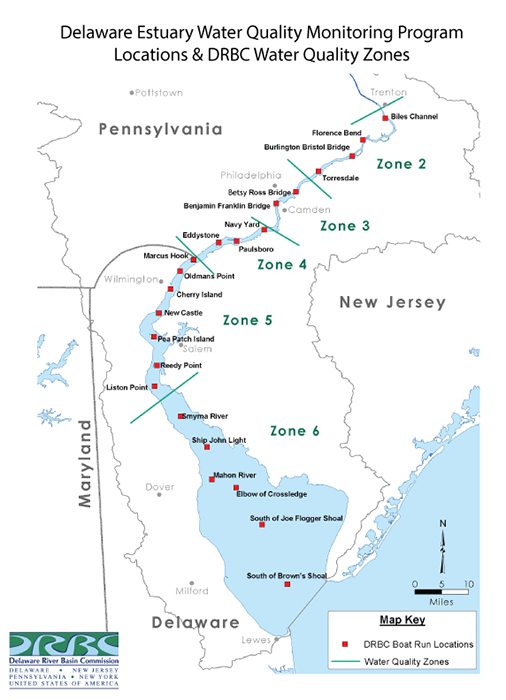Delaware • New Jersey • Pennsylvania
New York • United States of America
- Aquatic Life Designated Use Project
- Bacteria Monitoring
- Biomonitoring Program
- Chlorides Monitoring
- Contaminants of Emerging Concern
- Delaware Estuary Water Quality Monitoring Program
- Dissolved Oxygen and Nutrients
- Modeling
- Other Monitoring (e.g., Toxicity, Fish Tissue, Metals)
- PCBs and PMPs
- Special Protection Waters (SPW)
- Water Resource Data Sets
Initiated in 1967, DRBC's Delaware Estuary Water Quality Monitoring Program (aka the Boat Run) is one of the longest running monitoring programs in the world.
Each year, DRBC contracts with the Delaware Dept. of Natural Resources and Environmental Control (DNREC) to collect surface water samples in the Delaware Estuary, from the head of tide at Trenton, N.J. to the mouth of the Delaware Bay.
- Navigating the Depths: Inside the Delaware Bay's Longest-Running Water Quality Monitoring Program (article in DNREC's Outdoor Delaware online magazine about the Delaware Estuary Water Quality Monitoring Program; 2024)
Samples are collected at 22 stations to manage water quality and ensure that criteria are being met. Currently samples are collected from March/April - October.
This monitoring program provides accurate, precise and defensible estimates of the surface water quality of the Delaware Estuary and allows assessment of water quality criteria compliance.
Sample analysis includes:
- Dissolved Oxygen, pH, temperature, specific conductance, turbidity, secchi depth, PAR
- Nutrients (ammonia, nitrate + nitrite, phosphorus)
- Sodium, chloride, chlorophyll-a
- Bacteria
- Metals
- 1,4-Dioxane
- 6-PPDq
- low level Bromide (a bromide/chloride comparison can help determine if increased chloride levels are from road salts)
Bacterial sampling results for fecal coliform and enterrococcus are posted below.
Other data are added into the U.S. EPA's Water Quality Portal, which is available to the public.
Map of Sampling Locations
Typically, once monthly from March to October, bacteria samples are collected at the 22 stations. Fecal coliform and enterococcus bacterial data (unit of measurement is cfu/100mL) are used to determine compliance with the Commission's water quality standards for recreational use. Learn more.
DRBC's bacterial water quality criteria standards are based upon the average of several samples over a period of time. While individual samples taken on a single day such as those reported here may exceed the number listed under the standard column, the standard is not violated until the average of multiple samples within a Water Quality Management Zone exceeds the standard value. Bacterial data are highly variable, and individual sample exceedances commonly occur following rainfall events due to non-point source runoff and discharges from combined sewer overflows.
Most Recent Bacterial Sampling Data: October 2025
|
Sampling
Site |
River
Mile |
10/6/25 Enterococcus |
Enterococcus
Std. |
10/6/25 |
Fecal |
|
Trenton
|
131.04
|
29
|
33
|
180
|
200
|
|
Florence
|
122.4
|
37 |
33
|
80
|
200
|
|
Burlington
Bristol Br. |
117.8
|
22
|
33
|
110
|
200
|
|
Torresdale
|
110.7
|
4 |
33
|
97
|
200
|
|
Betsy Ross Br.
|
104.75
|
4
|
88
|
130
|
770
|
|
Benjamin
Franklin Br. |
100.2
|
22
|
88
|
>600
|
770
|
|
Navy Yard
|
93.2
|
6
|
88
|
190
|
770
|
|
Paulsboro
|
87.9
|
2
|
88
|
130
|
770
|
|
Eddystone
|
84.0
|
2
|
88
|
52
|
770
|
|
Marcus Hook
|
78.1
|
4
|
35
|
93
|
200
|
|
Oldmans Pt.
|
74.9
|
2
|
35
|
100
|
200
|
|
Cherry Island
|
71
|
24 |
35
|
100
|
200
|
|
New Castle
|
66.0
|
24
|
35
|
150
|
200
|
|
Pea Patch Is.
|
60.6
|
41
|
35
|
87
|
200
|
|
Reedy Island
|
54.9
|
ND
|
35
|
70 |
200
|
|
Liston Pt.
|
48.2
|
ND
|
35
|
35
|
200
|
|
Smyrna River
|
44.0
|
ND
|
35
|
12
|
200
|
|
Ship John Light
|
36.6
|
ND
|
35
|
ND
|
200
|
|
Mahon River
|
31.0
|
ND
|
35
|
ND
|
200
|
|
Elbow of
Crossledge Shoal |
22.75
|
ND
|
35
|
ND
|
200
|
|
South of Joe
Flogger Shoal |
16.5
|
ND
|
35
|
ND
|
200
|
|
South Brown
Shoal |
6.5
|
ND
|
35
|
ND
|
200
|
If results are flagged with the indicator "QC," the calculated precision between the analytical and duplicate results is outside the quality control limit for this test.
For additional details, contact John.Yagecic@drbc.gov.
n/a = data not available
ND = non-detect
Previous 2025 Bacterial Data (pdf)
DRBC staff developed an interactive application that allows the user to explore water quality data collected from the DRBC Delaware Estuary Water Quality Monitoring Program (aka the Boat Run) since 1999.
Check out the Data Explorer
Copyright © Delaware River Basin Commission,
P.O. Box 7360, West Trenton, NJ 08628-0360
Phone (609)883-9500; Fax (609)883-9522
Thanks to NJ for hosting the DRBC website